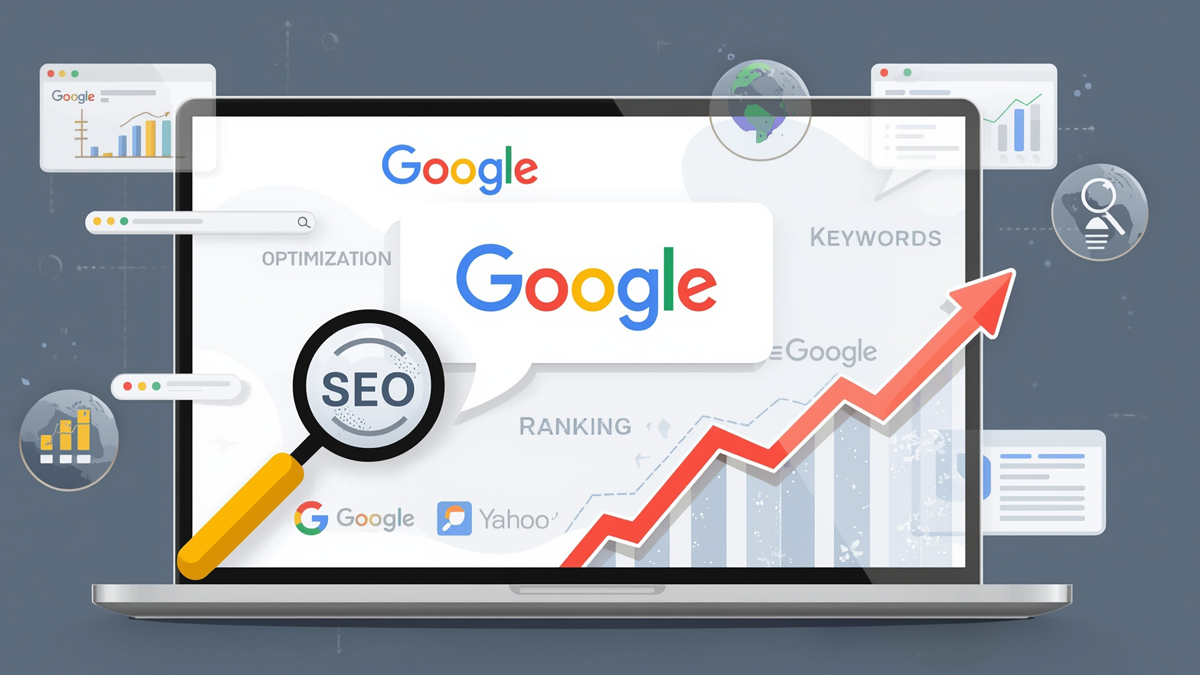Complete Guide to SEO: What It Is and How It Works

What Is SEO and How Does It Work?
SEO (Search Engine Optimization) is the systematic optimization of a website and its content, with the goal of properly presenting your pages to search engines and helping users quickly find what they are looking for.
A well-structured SEO strategy combines technical foundations, content quality, and authority - ensuring steady organic traffic and long-term sales.
The process includes three core improvement stages: crawling, indexing, and ranking. These allow search engines to understand a page’s topic, quality, and relevance to a user’s query.
Good SEO means having a clear topical focus, high-quality content, a technically sound website and strong external backlinks.
The Anatomy of Search Results
Search results typically include the title link, snippet/description, site name, domain and breadcrumbs, and sometimes sitelinks and rich results.
SERPs (Search Engine Results Pages) are made up of paid results and organic results.
Unlike paid ads, organic results do not generate revenue for Google. Instead, they are displayed based on a site’s relevance and quality evaluation.
Depending on the search query, Google may also include elements like maps, images, or videos in the SERP.
The number of ads shown in the SERP depends on the intent behind the user’s search:
For example, if you search for “shoes”, you’ll likely see that most of the top results are ads. In fact, you might need to scroll down to find the first organic result.
This is because such queries strongly signal purchase intent, and many shoe companies are willing to pay for higher ad placements.
On the other hand, if you search for “Atlanta Falcons”, the results will look different. Since this query is mostly related to the professional American football team, the top results include news articles and the official homepage.
Here, Google doesn’t know your exact intent but provides quick options - to learn about the team, read their latest news, or visit their website.
Because there’s no clear purchase intent, advertisers are not bidding on this keyword, so no Google Ads results appear.
However, if you modify your query to “Atlanta Falcons hat”, this signals to Google that you may be ready to purchase. As a result, the SERP changes to display more sponsored listings alongside organic ones.
In addition to these ads, off-page SEO factors such as external backlinks and strong link-building strategies help you stand out in organic rankings.
Acquiring inbound links from other trusted websites can significantly increase your site’s authority in search engines.

Search Engine Crawling
The first step is crawling. Search engines send out web crawlers to discover new pages and record information about them. These web crawlers are often referred to as “spiders,” “robots,” or “Googlebots.”
Their purpose is to identify newly created web pages and to regularly check previously visited pages to see if they have been changed or updated.
Search engines crawl web pages by following links from already discovered pages.
For example, if you have a blog that is linked from your homepage, when a search engine crawls your homepage, it will look for additional links and may follow them to discover your new blog post.
Search Engine Indexing
The second step is indexing. Indexing is the process by which a search engine decides whether to use the content it has crawled.
If a crawled web page is deemed valuable, it is added to the search engine’s index.
This index is later used during the final ranking stage. Once a web page or piece of content is indexed, it is archived and stored in a database, where it can later be retrieved and displayed in search results.
Most web pages that provide unique and valuable content are included in the index.
A page may not be indexed if:
The content is considered duplicate,
The content is considered low value or spammy,
The page cannot be crawled,
The page or domain has no inbound links.
You can check your indexed pages by typing site:yourdomain.com in the Google search bar. This will show you the pages currently visible in Google.
Search Engine Ranking
The third and most important step is ranking. Ranking can only occur once the crawling and indexing processes are complete.
So, once your site has been crawled and indexed, it can then be ranked.
Search engines use more than 200 ranking signals to sort and position content in search results.
These signals generally fall under the three pillars of SEO: technical optimization, on-page optimization, and off-page optimization.
Some examples of ranking signals search engines use include:
Keyword in the title tag - Does the keyword (or its synonym) appear in the page content and title tag?
Page speed - Does the web page load quickly and is it optimized for mobile devices?
Domain authority - Is the page and overall website considered authoritative for the searched topic?
Backlinks - The quantity and quality of inbound links pointing to the page.
Content quality and relevance - Is the content valuable and aligned with the target audience’s intent?
Mobile optimization - Are pages, content, and images optimized for mobile devices?.

On-Page Optimization
On-page SEO refers to optimizing the content and structure of your website so that search engines can properly understand it while providing real value to users.
On-page SEO includes:
Working within the website itself
Using a clear content hierarchy (H1-H2-H3)
Relevant title tags and meta descriptions
Readable and user-friendly URLs
Proper anchor text usage
Meaningful internal linking
Off-Page Optimization
Off-page SEO covers all optimization methods that take place outside of your website, rather than on it.
The primary technique for off-page SEO is building backlinks, since quality backlinks from external websites signal to search engines that your site is valuable and trustworthy - strengthening your domain authority.
There are many strategies for building backlinks. Some of the most effective include:
Publishing guest posts and high-value articles
Creating comprehensive toolkits or guides
Leveraging influencer marketing content
The key to backlinks is quality over quantity.
One high-quality backlink (for example, from Forbes or The New York Times) is worth far more than 100 low-quality links.
Local SEO
In Local SEO, Google takes into account three key factors: relevance, distance, and prominence.
It is essential to complete and verify your Google Business Profile, keeping your address, phone number, business hours, categories, and photos updated - along with collecting genuine customer reviews.
For example, if you own a restaurant, applying local SEO strategies ensures that when people in your area search for “best restaurants in town,” your business is more likely to appear in the results.
Technical SEO
Technical SEO ensures that search engines can efficiently crawl, index, and rank your website.
Even the best content and backlinks won’t help if your website suffers from slow loading times, broken links, mobile accessibility issues, or security vulnerabilities.
Optimizing these technical elements is crucial for improving your site’s performance and achieving higher rankings in search results.
YouTube SEO
YouTube SEO is the process of optimizing your videos and channel to rank higher in YouTube search results.
It involves applying various strategies and techniques to attract more organic traffic and present your content to your target audience.
To rank videos higher on YouTube, it’s important to first understand the YouTube algorithm and the ranking factors it prioritizes.
Hashtags are a great way to increase the visibility of your videos. You can add relevant hashtags to your video titles and/or descriptions.
Just like on other social platforms, users can click on or search hashtags on YouTube to discover content related to specific topics.
Be careful not to overuse hashtags: using too many may make your content appear spammy and reduce engagement.

Mistakes to Avoid
Spammy tactics - such as spam links, expired domain abuse, scaled content abuse, and site reputation abuse - along with mass-produced low-value content, keyword stuffing, and misleading UX, all create serious risks ranging from reduced visibility to complete removal from search results.
Always follow Google Search Essentials and spam policy guidelines.
Your content should clearly identify authors, and your website must include a Privacy Policy and Terms & Conditions pages to build trust and credibility.
Keyword Research
Keyword research is the “map” of your SEO strategy.
It helps you understand what your audience is searching for, which terms and phrases they use, and what kind of content you should create to answer those queries better than your competitors.
Image Optimization and Alt Text
Alt text refers to the description of an image, traditionally used to provide information to visually impaired users.
Beyond accessibility, alt text can also include targeted keywords to improve search engine rankings.
For best performance:
Upload images in AVIF or WebP formats, while keeping JPEG/PNG as fallback options for compatibility. These formats deliver smaller file sizes at the same quality, resulting in faster load times.
Give files clear, descriptive names (e.g., modern-sofa.avif rather than IMG_1234).
Place images near thematically relevant text; surrounding words and captions help search engines understand the image’s context and relevance.
Internal Links, Proper URLs, and Breadcrumbs
Internal links. Internal links serve two purposes:
Help Google discover and crawl your other pages.
Indicate which pages are thematically important.
Links should be natural and descriptive, not generic phrases like “click here.”
It’s best practice to link to deeper pages (avoiding “orphan pages”) and ensure key sections of your website are reachable within 2–3 clicks.
Proper URL structure.
Use short, human-readable words in URLs.
Separate words with hyphens (-) instead of underscores - search engines interpret hyphens correctly.
Avoid meaningless parameters or long IDs in URLs.
When necessary, use canonicals to consolidate duplicate versions.
Breadcrumbs.
Breadcrumbs display a user’s location within the website hierarchy and allow easy navigation back to higher levels.
Implement breadcrumbs with clear visible navigation and use BreadcrumbList structured data (JSON-LD) so Google can better interpret your site’s hierarchy (and display it in search results when possible).
Validate your schema and ensure breadcrumb URLs follow your chosen standards (canonical, slashes, lowercase, etc.).
XML Sitemap, Canonical, Robots.txt
Sitemap. Helps Google find and understand URLs, especially on large, media-rich, or multilingual websites.
Highly recommended for big or frequently updated sites; may not be necessary for small websites with fewer than ~500 pages.
Submit your sitemap via Google Search Console or reference it in robots.txt using the Sitemap: directive.
Canonical. Consolidate duplicate or near-duplicate pages by specifying the preferred (canonical) URL.
Robots.txt. Control crawling, but block indexing with noindex or password protection instead.
Do not list in your sitemap any paths that are blocked via robots.txt.



